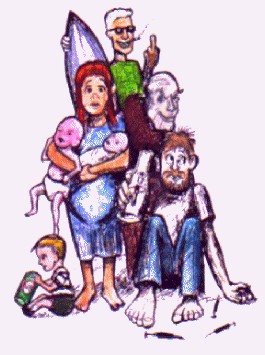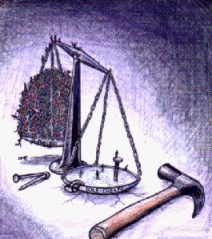In the spirit of dialogue, I have recently outlined some of my concerns and experiences as a welfare recipient. The book is titled "The Golden Lie." I have not yet secured a publisher for this work, although one is currently scrutinising my manuscript. I am also still in the process of obtaining permission to use quotes contained in the text.
Nick Costello - May 2001

Why the Government's welfare reform plan won't work
The government's welfare reform agenda is likely to fail because it is fundamentally flawed. It identifies "welfare dependency" as a major problem and argues that employment is the best solution, yet fails to take unemployment statistics into account.
Instead, unemployment has been viewed as a lifestyle choice, and welfare dependency treated as a personal shortcoming. Greater emphasis has been placed on community prejudice than on statistical facts, and the regime dubbed "Mutual Obligation" operates by edict rather than dialogue.
The recommendations of the McClure report emphasise the need for community support for disadvantaged people, yet government statements reflect the belief that many welfare recipients do not deserve such support.
These things raise questions about the philosophy upon which welfare reform is based, and force us to ask how such a narrow approach to a major issue has escaped challenge so long. Here are a few things to consider
The Opportunities Gap
In the closing years of the twentieth century, Australian society experienced a radical shift in fortune and values. Globalisation of industry led to a redistribution of wealth and work.
This, in turn, led to redundancies in the manufacturing and rural sectors. By the year 2000, thirty per cent of Australia's population lived in relative poverty, and 2.5 million of them survived on welfare.
Few of these people had the opportunity or resources-base to do more than live from day to day, and their ability to interact with mainstream society diminished rapidly.







The Denial
In 2001, Australian society was on the horns of a moral dilemma. Changing economic conditions threatened long-cherished notions of egalitarianism and equal opportunity. Mainstream Australians claimed to value notions of co-operative democracy, yet our economy thrived through dedication to the competitive dictates of economic rationalism.
We were locked into a system which created winners and losers, yet we continued to delude ourselves into believing that the "lucky country" was also "the land of the fair go" for everyboby. We wanted to have our cake and eat it too, and for a long time, we succeeded. We preserved our notion of mateship by being selective about who we called our mates.
As pockets of economic disadvantage emerged across the country, lines were drawn in the sand and differences were put down to philosophy.
Because our membership of the national community had been built on our shared pursuit of the "Australian Dream", we came to view people not participating in that quest as outsiders. We couldn't believe they had missed out on opportunities, so we convinced ourselves that they chose to be poor because it was easier than working for a living.
In spite of official statistics proving there were many more unemployed people than job-vacancies, politicians and media often peddled the notion that welfare dependency was a lifestyle choice, and taxpayers willingly went along with it. Over time, we came to view welfare dependency as a personal shortcoming rather than a product of economic and industrial change.







The Wall of Silence
While much is said in Parliament and in the media about unemployment, almost no consideration at all is given to the plight of unemployed people or the difficulties they experience on a daily basis. Discussion is largely based on figures and trends, with little regard for the human anguish that accompanies the experience of being without work.
This is no accident. In a very real sense, the social dynamic can be likened to a hostage situation. Imagine, for a moment, a scenario in which an armed bandit has attempted to rob a bank, but one of the tellers has activated a silent alarm. The police have responded and surround the bank before the bandit can escape. The bandit takes the staff and customers hostage, and a siege begins. In due course, a police negotiator is called in. One of his tasks is to encourage the hostage-taker to view his prisoners as individuals, with names, families and lives of their own. Theoretically, this makes it more difficult for the bandit to hurt them, and in this instance, it works. After several hours, the bandit surrenders and nobody is harmed.
Australian welfare recipients are hostages of a different kind. The most conspicuous of them - unemployed people - are trapped below the poverty-line, but no effort is made to humanise their dilemma. On the contrary, politicians and media demonise them as "dole-bludgers" and actively refrain from exploring the grim reality of their situation. Of course, if the truth was known, more community sympathy would be shown to them, but that's not what the spinmeisters want. Make no mistake, this is no accident; it is a calculated process of exclusion.
The Wall of Lies
Public discussion of unemployment is peppered with misinformation. Many aspects of life on welfare go unreported altogether. Reasons for this are probably political, but the fact that intense emotions are stirred whenever it is discussed suggests that a social phenomenon - or perhaps even a primal imperative - is at work here. A few examples and suggested reasons for bias appear below.
The Unemployment Iceberg
Unemployment statistics are expressed in percentages rather than raw numbers. Because of this, benchmark averages are set halfway between the highest and lowest levels of fluctuation. For example, if unemployment fluctuates between 7 and 9 per cent, the average is 8. When unemployment exceeds 8 per cent, alarm-bells sound, and when it drops below 7 per cent, politicians enthusiastically call for celebrations.

Unfortunately, the gap between 7 and 9 per cent represents less than 20 per cent of the total number of people officially listed as unemployed, and 4 per cent of all welfare recipients of workforce age. In reality, many thousands of people are treading water in an unemployment ocean while bean-counters amuse themselves with tidal changes. Another way of looking at the same situation might be to liken unemployment to an iceberg, with the majority of its mass hidden below the surface.
The Golden Lie
A nation's financial strength is measured by economic indicators. The unemployment-rate os one of these indicators. Fluctuations in unemployment can influence such things as interest-rates, currency-exchange-rates, and investor confidence. This presents governments with a powerful incentive to maintain a low level of unemployment - at least on paper.
If they can't do it by increasing employment opportunities, they might be tempted to manipulate statistics to create the illusion that unemployment is a less serious problem than it really is. I call this deception the "Golden Lie".
In Australia, the Golden Lie manifests itself in two main ways. The first involves siphoning some unemployed people away from Newstart Allowance and on to Youth Allowance, Disability Pesion and Single Parent Pension. Evidence of this can be found in the government's desire to apply an "activity test" to the latter two groups without reclassifying them as unemployed.
The second involves propoganda suggesting that unemployment is a lifestyle choice. In spite of the fact that official unemployment figures indicate that jobless people outnumber job vacancies many times over. Viewed from an economic point-of-view, the Golden Lie is a practical response to a serious problem, but it has a sinister downside. If it remains unchallenged for too long, people begin to believe it.
The myth of the dole-bludger becomes accepted as fact, and processes of social exclusion deepen the divide between rich and poor. Awareness of the Golden Lie leads us to question claims that unemployment is a personal lifestyle choice for jobless people. It also forces us to ask if media has been encouraged to perpetuate myths in the interest of national security.
The Power of Mythology
Mythology is a powerful force in human societies. In Australia, one of our most popular myths is the myth of egalitarianism. We live in the 'land of the fair go, ' and we love that notion with such a passion that we are prepared to shout down anybody who says it isn't so. Rather than admit that unemployment is a product of a shortage of opportunities, we blame the victims, and another myth - the myth of the dole bludger - comes into play.
The myth of the dole bludger performs an important social function. It enables us to distance ourselves from the darker side of our lives. In ascribing qualities like laziness and greed to unemployed people, we convince ourselves that they have nothing in common with us and, in fact, belong to another society. In doing this, we can reassure ourselves that our society - which stops at the poverty line - is truly fair and equal.
Scales of Injustice
The notion that welfare recipients are "cheats" is popular, in spite of the fact that only 400 people were prosecuted for welfare fraud in 1999. Even if that figure was increased tenfold, to allow for rorters who escaped detection, the total would still be a mere drop in the ocean when compared to the number of people receiving welfare payments.
The Media Whitewash
For reasons best known to themselves, media executives have consistently avoided asking the hard questions about unemployment. Most media organisations tend to avoid reporting anything more than the bare statistical facts, but some delight in fanning the fires of community resentment by presenting misleading reports.
A classic example of this was the A Current Affair ambush of the Paxton family. When Mike Munro defended ACA's treatment of the Paxtons, he described the reports as " a serious investigation of long-term unemployment." Of course, it was no such thing.
The opportunity existed to examine many aspects of joblessness, but all ACA seemed interested in was a witch-hunt. More recently, I experienced similar treatment when I appeared in an ACA interview. I was already on record as a critic of Channel Nine's biased reporting, so I wasn't sure if the treatment I received was just another day at the office for the ACA team, or if an effort might have been made to discredit me.
More recently, I have written a book about unemployment and welfare politics in Australia. In it, I discuss this ACA incident, and other examples of media bias. I recently approached Channel Nine for permission to use quotes from the report in which I appeared, plus other examples of Channel Nine's biased reporting. Not surprisingly, permission was denied.
Unanswered Questions
In spite of government assurances that we have a strong economy, unemployment looks set to rise in coming years. The impacts of globalisation, automation and possible recession have yet to be fully assessed, but many a politician runs for cover when questioned about these issues. On rare occasions, their avoidance is so obvious that we are forced to conclude that they have something to hide.
This happened twice in the space of two days in April, 2000. On April 3rd, Senator Brian Harradine asked Jocelyn Newman a question in Parliament about the impact of the"stress of unemployment" on families. Senator Newman responded by describing marriage break-up as a major cause of poverty among children, then sang the praises of government incentives to encourage people to take up available work. At no stage did she seek to address the question of stress among unemployed people.
Two days later in the House of Representatives, the Prime Minister engaged in a similar piece of avoidance. The ALP Member for Chilfey, Roger Price, asked him to repudiate Tony Abbott's "job snob" attack on unemployed people, but he had no intention of doing so. Instead, he explained that the worth of a Minister for Employment Services was measured by the contribution he made to reducing unemployment. Mr Howard then went on to sing the praises of his government's achievements. At no stage did he openly support or criticise Abbott's comments, nor did he offer any words of support to unemployed people.
An Evasive Response
Last October, I decided to ask various politicians a direct question. I didn't really believe that any of them would give me a straight answer, but I felt obliged to ask anyway. The question read as follows:
"Given that employment is the main alternative to reliance on income-support; and given that Bureau of Statistics figures show that unemployed people outnumber job vacancies several times over; and given that automation and globalisation have led to job-losses - particularly in the manufacturing and rural sectors: by what criteria has the government decided that "welfare-dependency" is the chosen lifestyle of income-support recipients ?
In short, how can dole-bludger innuendo form the basis of government welfare policy ?"
I sent emails containing this question to:
- Minister for Family and Community Services, Jocelyn Newman;
- the Minister for Community Services, Larry Anthony;
- the Minister for Employment Services, Tony Abbott;
- the Shadow Minister for Employment Services, Cheryl Kernot;
- and Mark Latham.
The only reply I received came from the Department of Family and Community Services (dated 15-11-2000).
It was from David Kalisch, Executive Director of Social and Economic Participation, who wrote on behalf of the Minister for Family and Community Services and the Minister for Community Services. It read:
Dear Mr Costello,
The Minister for Family and Community Services and the Minister for Community Services have asked me to reply to your email of 22 October 2000 about the Government's welfare reform program.
The OECD had found, and it is now well accepted, that the best route out of poverty is through employment. Australia, like many other countries, has moved towards approaches that are active rather than passive, including support and encouragement to build people's skills and help them to move back into the workforce, where they are able to do so.
The Government is committed to maintaining a sustainable and adequate safety-net for people who are genuinely in need. However, the Government also recognises that it is necessary to do more to link people more actively to opportunities for social and economic participation.
The Final report of the reference group on Welfare Reform provides a framework for long-term reform aimed at reducing economic and social disadvantage over time and encouraging increased economic and social participation, depending on capacity. The Reference Group's recommendations are consistent with the Government's social policy agenda and built on some of the changes that the government has already put in place. The Government will respond formally to the Report before the end of this year. Thank you for writing. I hope my comments are of assistance.
Yes; Mr Kalisch's comments were of assistance. They proved to me that the Coalition had no desire to confront the realities of unemployment.







Release the Hostages
Australia's industrial landscape is changing. The levels of employment seen in the 1970s and '80s are not likely to be seen again for some time.
Unemployment in the rural and manufacturing sectors is rising, and many older people displaced by globalisation are not likely to work - in the traditional sense - again in their lives. They are hostages whose plight has been ignored by a government and a society obsessed with keeping up appearances.
What welfare recipients need most is a place to belong in society. They need meaningful work where possible, and at least enough money to pay their basic living expenses. Just as important, they have a right to live with dignity - free of blame for the situation they find themselves in.
As the brave new world of globalised industry gathers strength, welfare dependency in Australia is certain to increase. If our social fabric is to remain strong, notions of Mutual Obligation and a Social Coalition must be accompanied with genuine dialogue. In that process, an examination of prejudice and processes of social exclusion in the welfare sector will be necessary. That will probably open up a huge can-of-worms, but if we continue to pretend we don't have a problem, the gap between rich and poor can only widen.

